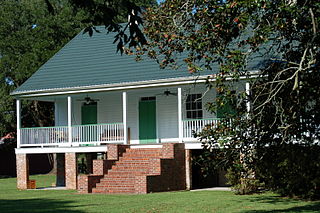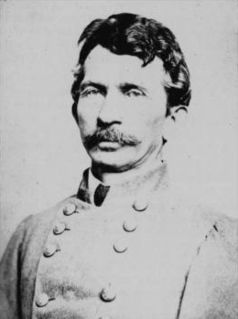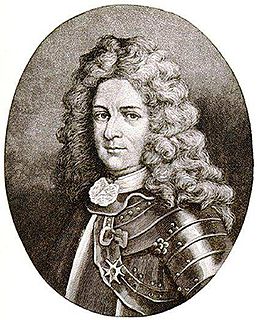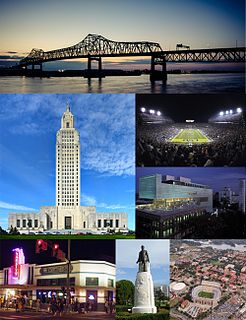
West Baton Rouge Parish is one of the sixty-four parishes in the U.S. state of Louisiana. As of the 2010 census, the population was 23,788. The parish seat is Port Allen. The parish was created in 1807.
The Battle of Plains Store or the Battle of Springfield Road was fought May 21, 1863, in East Baton Rouge Parish, Louisiana, during the campaign to capture Port Hudson in the American Civil War. The Union victory closed the last Confederate escape route from Port Hudson.

Melvin Lee Holden, known as Kip Holden, is an American politician who served from 2005 to 2016 as the Democratic Mayor-President of Baton Rouge and East Baton Rouge Parish, Louisiana, USA. The parish includes the state capital of Baton Rouge and smaller suburban cities such as Baker, Central City, and Zachary.

The Capture of Fort Bute signalled the opening of Spanish intervention in the American Revolutionary War on the side of France and the United States. Mustering an ad hoc army of Spanish regulars, Acadian militia, and native levies under Gilbert Antoine de St. Maxent, Bernardo de Gálvez, the Governor of Spanish Louisiana stormed and captured the small British frontier post on Bayou Manchac on September 7, 1779.

Henry Watkins Allen was an American soldier and politician. He made it to the rank of brigadier general in the Confederate States Army during the American Civil War.

Antebellum Louisiana was a slave state, where enslaved African Americans had comprised the majority of the population during the eighteenth century French and Spanish colonial period. By the time the United States acquired the territory (1803) and Louisiana became a state (1812), the institution of slavery was entrenched. By 1860, 47% of the state's population were enslaved, though the state also had one of the largest free black populations in the United States. Much of the white population, particularly in the cities, supported southern states' rights and slavery, while pockets of support for the U.S. and its government existed in the more rural areas.

The Pentagon Barracks, also known as the Old United States Barracks, is a complex of buildings located at the corner of State Capitol Drive and River Road in Baton Rouge, Louisiana, in the grounds of the state capitol. The site was used by the Spanish, French, British, Confederate States Army, and United States Army and was part of the short-lived Republic of West Florida. During its use as a military post the site has been visited by such notable figures as Zachary Taylor,
Lafayette, Robert E. Lee, George Custer, Jefferson Davis, and Abraham Lincoln.
B-276 Kostroma is a Russian Sierra-class submarine. She was launched in 1986, commissioned in 1987, and named K-276 Crab until 1992. Kostroma was built at Gorky and later towed to Severodvinsk for completion. She is part of the Russian Northern Fleet.

Magnolia Cemetery is a 10-acre (4.0 ha) cemetery in Baton Rouge, Louisiana.
The 14th Maine Volunteer Infantry Regiment was mustered in for three years' service on December 31, 1861, and was mustered out on January 13, 1865. It lost 86 killed or died of wounds and 332 died from disease.

The foundation of Baton Rouge, Louisiana, dates to 1721, at the site of a bâton rouge or "red stick" Muscogee boundary marker. It became the state capital of Louisiana in 1849.
The 1997 LSU Tigers football team represented Louisiana State University in the 1997 NCAA Division I-A football season. Coached by Gerry DiNardo in his third season at LSU, the Tigers played their home games at Tiger Stadium in Baton Rouge, Louisiana.

1st Regiment Indiana Heavy Artillery was a heavy artillery regiment that served in the Union Army during the American Civil War. It was nicknamed the "Jackass Regiment". Before being converted into an artillery unit in 1863 it served as the 21st Regiment, Indiana Volunteer Infantry.
The Red River State Fair Classic is an American college football game played annually in Shreveport, Louisiana, at Independence Stadium during the State Fair of Louisiana. It traces its historical lineage from a series of 160 games played over the 106 football seasons between 1911 and 2016. By having first paired historically black colleges and universities in 1922, the contest holds the distinction of being the oldest annual black college football classic, edging out the Turkey Day Classic by two years and the similar Texas State Fair Classic by three years. Also, so far, the earliest documented use of the term "classic" as part of an annual black college football game's formal name has been dated to the 1927 Louisiana State Fair Classic.

The attack on the SS Baton Rouge Victory was a commando attack launched by the Viet Cong on August 26, 1966, in which they attacked the Victory ship SS Baton Rouge Victory using two 2,400-pound limpet mines while it was proceeding along the Lòng Tàu River, about 22 miles (35 km) southeast of Saigon. The explosions killed seven American civilian sailors on board and tore a 16-by-45-foot hole in the ship's hull forcing the captain to run the ship aground to avoid sinking and blocking the shipping channel. Water rushed the hole and immediately flooded the ship's engine room, seven of the nine crew members working in the engine room drowned. Only the Chief Engineer and an Oiler were able to get out of the engine room. The SS Baton Rouge Victory had departed the San Francisco Embarcadero on 28 July 1966 with a crew of 45, loaded with military trucks and other heavy equipment. She was refloated on 30 August 1966 and towed to Vũng Tàu. In 1967, she was scrapped at Hualien, Formosa, now called Taiwan.
The Baton Rouge bus boycott was a boycott of city buses launched on June 19, 1953 by African-American residents of Baton Rouge, Louisiana who were seeking integration of the system. They made up about 80% of the ridership of the city buses in the early 1950s but, under Jim Crow rules, black people were forced to sit in the back of the bus, even when the front of the bus was empty. State laws prohibited black citizens from owning private buses outside the city systems.

The SS Baton Rouge was a cargo Victory ship built during World War II under the Emergency Shipbuilding program. The Baton Rouge (MCV-846) was a type VC2-S-AP2 Victory ship built by Bethlehem-Fairfield Shipyards. The Maritime Administration cargo ship was the 846rd ship built. Her keel was laid on June 21, 1945. She was launched on August 22, 1945 and completed on September 24, 1945. The 10,600-ton ship was constructed for the Maritime Commission. The American Export Line and later the Isthmian Steamship Company operated her under the United States Merchant Marine act for the War Shipping Administration.












